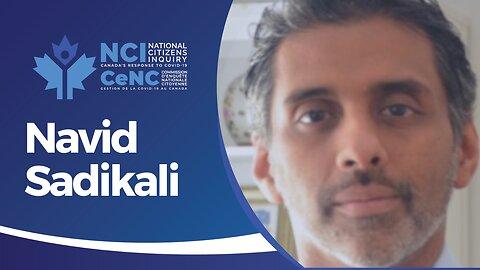As both a medical scientist and a tech trailblazer, Mr. Sadikali questions the events leading up to the pandemic and who and how COVID and vaccines were handled. Speaking of our body’s immune system he said, “I don’t even think mankind could recreate it. And it’s extremely complex. One of the most complex systems on the earth are the way all these characters work together.”
* The above video is being streamed via Rumble. Check back often as we continue to update the complete list of links to all witness testimonies in both video and audio/podcast formats.
[00:00:00]
Wayne Lenhardt
The next witness is going to be Navid Sadikali, I hope I pronounced that correctly. And I see him on the screen.
Good afternoon, Navid, my name is Wayne Lenhardt and I’m going to be doing an oath with you and asking you some questions today. Could you give us your full name, spell it for us, and then I’ll do an oath.
Navid Sadikali
Navid Sadikali, N-A-V-I-D S-A-D-I-K-A-L-I.
Wayne Lenhardt
Do you promise to tell the truth, the whole truth, and nothing but the truth during your testimony today?
Navid Sadikali
I do.
Wayne Lenhardt
Okay. I understand that you have some slides that you want to show us.
Navid Sadikali
Yes, I do.
Wayne Lenhardt
Sure, if you want to just launch into it and—
Navid Sadikali
Absolutely.
Wayne Lenhardt
And we’ll stop if we need to along the way.
Navid Sadikali
Absolutely. So just to give some background on myself and then I’ll jump into my slides.
Like many of you, I’ve been navigating the world of some complex decision-making in health care and other matters for the last few years. But unlike some of you, I have experience leading innovation in healthcare firms, and that’s for 23 years.
In some sense we’re already connected. If you go into most hospitals in the world, there’s technology that I designed in the radiology department, cardiology department, so I’ll tell you a little bit about that. Then we’re going to go into something quite exciting and stay to the finish because there’s a really optimistic ending to this.
I’m going to share my screen now. I hope this comes through okay. All right. Has that come through?
Wayne Lenhardt
Okay. I believe you have a slide with all your credentials on it. I wonder if we could have that one next.
Navid Sadikali
Sure. Yeah, I’ll tell you a little bit about myself and then we’ll go through the rest.
In a sense I started after going to school in the United States, being recruited for rowing there, to Brown University. I got two degrees there and I went to University of Waterloo for my master’s. I have experience in science and in computer science technology and so the integration of that was medical imaging. I helped to disrupt the world medical industry, which was all film in the early 90s. And it’s Mitra, and then at Agfa, which— we were purchased as a startup. We ended the medical film industry and it all became digital.
And since then—for like I said, 23 years—I’ve been leading product design at different companies, most recently Canon Medical, where we had a $200 million portfolio. I designed big imaging systems used across the world in pretty much every hospital and many clinics. It impacts at least 200 million patients a year today. Those are products in radiology, cardiology, oncology, and surgery.
We started with this, which is— here are some of the hospitals I’ve been in.
Why does this matter to you? Well, basically, I’ve had to go into pretty difficult environments where there’s— both fun and difficult, where there’s a lot of opinions. Experts are at play and my job is to figure out what we should do as a company, where we should take medicine forward. We don’t just listen to experts because we’re the experts in medical device creation and that’s me. And so I have to sort of integrate many perspectives. And to do that you have to be quite open-minded, to listen to all sorts of opinions. And if you go to an academic teaching hospital versus a regular community hospital, things are very different.
Medicine looks many different ways in many different places. And my job as designer and the scientist is to bring that all together and help the engineers build the right products. So just to show you what that looks like, this is some of the technology that I’ve designed. So stroke imaging, cardiology imaging, general radiology. And so these are actual products where I’ve been in surgical wards to figure out how to push surgery forward. And I’ve seen many interactions with patients and oncologists to understand what we need to do better. So that’s my background.
I want to really focus it on us, which is you. And our goal today is to cut through the complexity—which is what I have to do anyway in medicine, right? To cut through all the complexity because most physicians aren’t interested in academic stuff, they’ve just got to get their work done.
There’s six stories I’m going to be telling. And those bring together three business stories and three scientific stories. And if you understand those, the world will be a very different place.
[00:05:00]
It’ll be a safer place. And if we can get the doctors out there—there’s a million doctors roughly in North America—if we get them to understand these stories in these 20 minutes, we won’t have another pandemic like we did. In fact, we may not have any more in some sense. And we’ll have to get into the specifics to see what I mean by that.
The first story I want to tell is just that in October 2019, “The Business” was preparing for a pandemic. And Event 201—some of you may not know about it; watch on YouTube— was an economic and business event to prepare for a coronavirus pandemic. They actually ran it like a war game; they ran a simulated pandemic for coronavirus.
And then what’s interesting to me, because I’m saying that business was leading, was that no physicians were invited to this simulation of a pandemic. And there’s a lot more to say about this. But really what we need to say is that this is business leading the charge; some of the biggest pharmaceutical companies on earth are there. What’s important is that it wasn’t science leading.
Who was inviting the people to this? It was the World Economic Forum. They were the ones who took the stand, gave the intro keynote. And what Ryan Morhard, the lawyer from the World Economic Forum said, “One of these days, a pandemic, a fast-moving pandemic.” That’s October 27, 2019. And then, if you look at what was said on day one of the pandemic, March 12, 2020: “There’s not going to be a way back to normal.” That’s what Ryan said on March 12, the first day of the pandemic.
This is business leading the way, because the scientific community had no idea that there was not going to be a back to normal. In fact, it wasn’t really clear what was happening in terms of the scientific community at that point.
I want to move on to the second story. I already did one, it’s great.
Now second story, a business story, is that December 12th, 2019—which is about three months before the pandemic was declared by the WHO [World Health Organization]—we have a legal agreement, a material transfer agreement between the University of North Carolina at Chapel Hill, Moderna, and Fauci’s NIAID [National Institute of Allergy and Infectious Disease]. And they were testing the mRNA corona vaccine candidate and this coronavirus vaccine candidate was a joint venture between Fauci’s NIAID and Moderna. And the University of North Carolina received this for animal challenge testing. Here’s the most well-known, prolific coronavirus spike protein researcher Ralph Baric signing this agreement. The patent holders of the spike protein that was used to create the vaccine— which has a long history and patent history, which I put links to there—was signing this. And Moderna signed.
So it’s a work that was happening before. Now what does this mean? We can’t really dive into that right now but just to say that, “Hey, look. Again, business was leading the way.” This is a business agreement, right? To do some business.
The third business story I want to tell is that billions were spent to market a lockdown. Some of you remember the NHS’s [U.K. National Health Service’s] Stay Home, Save Lives campaign. There was the same type of messaging through the world, actually. Campaigns were used, “Look them in the eyes and tell them to always keep a safe distance.” So quite in-your-face, hard-hitting advertising. This advertising was created in an agreement in the U.K. with the world’s top—I think it’s near the top—marketing agency called Omnicom, on March 2nd, 2020.
So that means they were in discussions in February to sign an agreement on March 2nd. That’s all before the pandemic was declared on March 11th. There’s a marketing business event happening before the pandemic started. And what’s really important to note if you’re an epidemiologist is: look, on March 3rd, the day after they signed a contract for lockdown or stay-at-home campaigns, there was only four cases in the U.K., and that’s 68 million people, and there were zero deaths. So the U.K. spent more than even World War II on an ad blitz—proportionally even more, accounting for inflation, than World War II—to market lockdowns and the sort of measures they wanted to take. And by the way, those measures were discussed at Event 201 in October 2019.
We could go into some of the agreements that were signed: the HHS [Department of Health and Human Services] in the United States signed $1 billion dollars for advertising;
[00:10:00]
$328 million with the Omnicom Group for “Stay Home, Stay Safe,” et cetera. You can see this. Nations spent heavily on lockdowns.
Now we’re going to move to the science. You’ve kind of got three business stories that I think, for those interested in science or in academia, they could look into those more. It’s a little bit of a push to spend more effort on this. So now to the science. Now the science was obviously being—had not advanced. So now we have Neil Ferguson. I won’t go into the full story, but he’s a modeller who’s had some bad successes in the past. He works for Imperial College. And his Excel file went around the world.
He had Imperial College, which is heavily funded by a private foundation called Gates Foundation. He created an Excel file and that Excel file went around the world. And it said something that’s quite dangerous: It said that we were going to have unmitigated, without lockdowns, which he was saying we needed trying to sell lockdowns— In Canada, we’d destroy Halifax, the equivalent of Halifax, in months. In the United Kingdom, it would be like 489,000, you can see their deaths. This is the Excel file, there’s a link to it. And in the United States, there’d be 2 million deaths—and we’re talking about in months. Like, that would be like the city of Houston.
And so obviously that kind of a scientific message from an individual somehow—and we think it’s through WHO and all the national governments— scared people. If you’re going to destroy Houston, well, you probably should lock down. So that’s the first scientific story. There’s a lot more to dive into there, but I think you need to know that that’s what actually happened.
So now we’re going to go to the fifth story. We’re advancing at a good pace here and I’m going to slow it down a little bit. The last two pieces, these two things are a little more technical. But everybody can understand these, so I’m going to go a little slower. And if everybody understands this, you’re going to be 99 per cent ahead of all the scientists and all the physicians on the earth—probably 99.99 per cent, to tell you the truth.
We’re going to go through the PCR test first. And the PCR test caused mass medical confusion. You’ve probably heard of this during the last few days, and I know many of the speakers have touched on it. We’re going to understand a little deeper and a little more visually. And you’re going to get it.
So first, you know that a virus is like computer codes; it actually is a coding system. This screen is all these letters that are proposed base pairs for coding for the length of the viral virus RNA, this proposed coronavirus. We can’t find them. We actually have no technology to find them very well, at least not at mass scale. What they actually do is they find this PCR test that finds a little bit of a bigger thing and say, “Well, if I find that, that’s indicative of the big thing.” And that’s already a bit of a hint. You’re not actually looking for it, you’re looking for something that looks like the thing you’re looking for, right? Sort of like, a bit of a clue.
When you do a PCR swab, it’s important to note: there’s billions of DNA bases in that swab. If you took all those bases like a code and overlay them all and put them over seven million kilometres of highway in North America—so that’s how much is coming in that little swab. DNA is really small and RNA is really small. Then how much would the PCR be looking for? We would be looking for, like, a 50-metre section of road in seven million kilometres. So we’re looking for something very small. And like I said, the virus is a lot smaller; it’s like 15 kilometres. We’re only looking for a 50-metre section and saying, “If we see that in all that stuff, we really have a virus.” What’s interesting about that is, obviously that’s really difficult. We can’t really look with a microscope for something that small.
So what PCR is, this is what you really need to know right here: it’s just a photocopier. If I take one page and I photocopy it and I get two pages, and I collate them, and I photocopy again, what am I going to get? I’m going to do one, two, I’ll get four. And I take all four and photocopy each one again, I’m going to get eight, right? So we get this doubling idea, which is what PCR is. It’s a photocopier just like this one, except it’s doing it with this little thing I found. Let’s photocopy it, make two. If I make two, I make four; and I make four, I make eight, and that’s the two to the power.
[00:15:00]
If you do that 35 times, you’ve lined up 35 photocopiers; you’ll get 34 billion viral PCR segment copies. Now really, it becomes DNA copy. It’s not the virus—remember that. And if you have 35 billion of something, you can imagine: well, now you can maybe see it. And you can because they sort of tag it with a light emitting element, a chemical that is going to light up. So basically, that’s how PCR works. It works by taking something small and making it really—amplifying, amplifying, amplifying, photocopying, photocopying, photocopying.
What’s the result of that? The result of that is that you take one: if I have one of these little pieces in my nose and if I duplicated that through that doubling 24 times, two to the 24[th power] is 16 million. Okay, does that mean you’re sick or not? Well, actually nobody could say on the earth. If I have 60 fragments, those little 60 pieces, and I do that 24 times, I have a billion. Am I now positive? But if I have one and I do that 30 photocopying duplications, I get a billion. Oh, and is that—?
This is not a test. This is a duplication thing that through some interpretive event says, “Maybe that’s a positive; maybe you’re sick, maybe you’re not.” It’s not a diagnostic test of sickness. So that’s one of the first and early confusions. And obviously it was sprung across all the physicians who, “Well, I guess the test works.” But they don’t really know the science of it, right? Because they don’t go to school for this: this is molecular genetics; it’s not something they’re really familiar with.
And so really, we don’t really know— With this test, the problem comes about that this duplication process, we don’t really know what is true or not.
Because of that, you have a lot of ways that this can be a false positive test. For example, if a kid breaks up the virus really quickly in his nose and he gets these little fragments, his snot will be positive, potentially for 90 days. That’s a false positive. If you walk into hospital Tim Hortons, let’s say, and you’re in the coffee line: someone sneezes and a little fragment goes in your nose, the virus or even a broken piece of it, then you’ll be positive. And you’re going to the hospital for something. So you could actually be there with another illness, but now you’re positive because you were in the hospital coffee line. Well, that’s not fair.
And of course, poor lab processes lead to contamination and that happens. And then high amplification leads to bad protocols—which we can’t even get into, there’s so many ways that can happen. With the reagents and different temperatures. Then you can just amplify the wrong RNA or DNA. You could actually have—and some people said you could make something that’s—you know, a brown trout matches, has sequenced like the one that they’re looking for in the PCR test. Now is brown trout in your nose? Well, probably not. But maybe. All right, we’re talking about little small elements of it.
There are many ways to get false positives. We’re not going to cover them, but here’s two scenarios that happened that impacted all of us. Fifty kids in a school—or all the kids in the school—are tested, but they’re all exposed a month ago. None were ever sick. Their natural killer cells broke that virus up, let’s say, and there are little fragments in there. You go to amplify them and they’re positive. Now you’ve got 50 quarantined kids that have no infection. And that can happen up to 90 days after they were exposed. And so for example, if you— that is unfair because you quarantine truly healthy people because of a test that’s really very iffy. It’s not a test of sickness, right? It’s a test of viral pieces.
The next thing that can happen is that our patient, like I said, goes into the hospital, short of breath, viral fragments in his nose; he’s lined up in the coffee shop. He goes for a PCR test so they can start treating him. He tests positive. Now he’s in the COVID funnel. And maybe he gets remdesivir because they think he’s a COVID patient. And maybe he gets put on a ventilator because he’s now tested positive. So now a whole protocol gets enacted because of a test that’s not even diagnostic, a real test, itself. This is sort of like a factory system, right? And medicine has to kind of work like that, but when you put a new technology in, it doesn’t always work well. And trust me, I’ve done— I’ve built FDA [Food and Drug Administration] products in the world, so I know about safety.
Okay. I can’t go into all the details. There’s so much here you can see I’ve put links to. But what this means for us is that all COVID statistics are uncertain and overstated: We have studies used to show 50 per cent, some doctors say 90 per cent. In certain cases, in certain times, right? This is a complex thing of when,
[00:20:00]
what PCR tests. There’s many vendors: some PCR tests could be completely bogus; some may be cycled less; and so, there’s, you know, the number of false cases will be 50 per cent.
What that means is that we don’t have any good data on cases, hospitalizations, and deaths. We know they’re overstated. What would have the world looked like if there was far less cases? Would they have been able to— would the fear have been instilled as well if there were less cases? No, absolutely not. Because the more you test, the more you’re getting cases; just from the false positive rate itself, you could create a steady line of positives.
Okay. What we want to say next is: the vaccine was never going to work. So now we’re going right into fundamentals. We don’t have to— we can debate about statistics and we’ll get into that a little bit, but what really we need to know is that when you inject into the arm, you make something called IgG blood-borne antibodies. You see that little guy with the hat? He’s orange. Those antibodies are in your blood; they’re circulating, I just get a portion of his body.
Now, when you get a natural infection in those cells, you get IgA antibodies. That vaccine can’t put those IgA antibodies in your mucosa, which is where you start getting infected. You don’t get infected in your arm, right? It goes through your mucosa and that’s how the system’s designed to block this. Basically, what this means is that the injection could never make IgA antibodies in your mucosa—nose, throat, intestinal tract is also mucosal entry point. So it could never stop infection; it couldn’t stop transmission because that thing will never make the things you need, the IgA in your mucosa. So by first principle, it was impossible. And of course, Gates now admits that.
So how did they get efficacy? And everyone’s wondering this and you’re going to get the answer now. How did they get efficacy from a vax that couldn’t work? How can they say “95 per cent” when you know that it couldn’t even work?
What’s happening here is that, when you get injected, it’s an immunosuppressant, right? There’s foreign technology in that shot. People have talked about polyethylene glycol and cationic lipids. And that stuff, your body’s immune system is like, “Oh, that’s a foreigner. I’m going to attack that.” What happens is you get the immune suppression and you’ll potentially get sick—especially if you’re exposed. Or it’s already there and you’ve already had it, but now you’re actually weakened and now your immune system can’t fight it off. So COVID cases rise after the first dose and after the second dose. We kind of can get that because it suppresses your immune system.
You get injected, you get a little bit of a fever—Israel had data that it was happening en masse to the whole population. I have to go back and look at the numbers, but it was well-documented this happened. And it has to happen because you’re injecting a foreign item in your body. So all we have to do to get efficacy is withdraw those people who get that after the first week or second. Don’t count those people, right? That’s what happened. In some studies, they call them “partially vaccinated”; in some they’re “unvaccinated”; and in some they’re actually—and I’m going to show you in the Pfizer study—we believe that some of them were just completely trashed. Like that data is not used, so they’re not in the study, ejected from the study.
Let’s look at the Pfizer data, which is the only— remember, this is the only randomized control trial we have. We have 311 withdrawals in the vaccine arm and 60 in the placebo arm. Well, why would that be? Why’d you have five times more withdrawals? They call it protocol deviation. Let’s say that we were injecting people and those 251 people got the— 311 minus 60, right? The vaccine had this many withdrawals. With the placebo, it’s only 60. It’s 251 that were just removed. If we take those 251, say, “maybe some of them got sick.” Let’s pronounce it: “They got sick, they got a fever, and the protocol said they have to be removed from the study.”
So then what does that mean? That means that on the left, we’re being told the vaccinated sickness was 9 in 169. That’s actually the numbers. That’s how you get— over 18,000: you divide those numbers, you get 95 per cent, right? If you put those people back, the 251 and the 9, you have more vaccinated getting sick than placebo. You have negative 53 per cent efficacy.
[00:25:00]
I’m saying on the left is what’s published, on the right is what’s likely. We would want— we’d have to go back and get all of that data, all of the site’s data. And what each person would happen to them out of the 260 that we’re saying were perhaps withdrawn because they got sick in the first few days.
But we don’t actually have to even look there. We have good published data that show this is actually happening for sure. The Government of Alberta proves that the newly vaccinated are at risk but counted as “unvaccinated.” So here we have—and they published this—time from immunization date to their COVID diagnosis. And these are the first 14 days. You can see that the graph goes way up the first 14 days. These are the deaths.
So you inject someone and they die. And I’m not saying causality. But if they die in the first few days, what’s important here is not causality: it’s that they’re removed from the study and put into “unvaccinated,” right? That’s what’s important. The first 14 days, they’re considered unvaccinated and all other days they’re considered vaccinated—even though they’re all injected. So when we look at their data, 56 per cent of the deaths were in the first 14 days and 44 per cent of the vaccinated deaths were in the other days. So these people are being put into the wrong bin.
If we look at Ontario, and this is right from the website: “Unvaccinated cases,” by definition, are “where symptoms started between zero and less than 14 days after receiving the first dose of a COVID-19 vaccine.”
This is the world’s biggest problem right now. This is it. This is right into the heart of it. Because you don’t have to debate statistics and say, “Well, this study shows that.” If you rerun all the data—and I’m proposing that scientists do this—rerun all the data thinking about this and saying, “Well, we’ve binned them this way. What if we binned them the other way? What if we consider them actually vaccinated if they got injected?” This is the source of the distortion.
And there’s studies coming out and people trying to talk about this. Thirty Sweden doctors published pushback on distorted mortality data in Sweden. And that link is on the bottom right. Like I mentioned, there’s lots of links in this presentation that I didn’t cover that you should look at.
Okay, so that covers all the six stories. The breadth of it is that there’s a business cycle that’s happening first, and then the scientific cycles coming, happening. It’s really, there’s vaccine cycles coming. And that constitutes, I think, the most important things the public really needs to understand and go, “Oh, wait, that’s kind of really a bit confusing and that’s not really telling me how it is.”
I want to leave with a sort of an optimistic future. My key point is that if people are being sickened by this vaccine technology, then we have to reconsider: is it really ready for prime time? That’s going to be up to many other people to do that. But we have to sort of be aware and mindful that potentially the statistics are leading this way—if we rerun the statistics, which we have to rerun.
But the optimistic future I want to leave is a perspective about, we’re kind of under-appreciating something scientific. Not just a little bit, a lot under-appreciating something that we all believe. I think really the heroes of this, really the potential way out of this— I think, and this is the big reveal: we have a pretty amazing set of fighting systems, probably the world’s greatest army we have. And it’s broad and it’s got a lot of pieces to it.
We have natural killer cells, which children have in some studies, five times greater than older adults. We have T cells. No one’s talking about, “Hey, how many people were immune already from T cells? How many people were immune from natural killer cells? We have a lot of technologies that are already built, purpose-built for this.
The optimistic message is that if we can keep ourselves healthy and really appreciate what we already have— We need to rerun statistics but, you know what? We were actually good. And secondly, we should appreciate that, look, that T cell right there with the sword: If he sees foreigners, if he sees mRNA technology in your heart, his job is to destroy it. If he sees that in your brain, his job is to destroy it.
So you need to be more careful what you’re putting in and saying:
[00:30:00]
Look, if this is causing your immune systems to fight and damage, you’re fighting yourselves, right? We need to be on side with “Hey, this is, by estimation, $100 trillion technology.” I don’t even think mankind could recreate it. And it’s extremely complex. One of the most complex systems on the earth are the way all these characters work together. I haven’t even talked about neutrophils and macrophages and mast cells and B cells and helper T cells. And there’s a lot of pieces, right? And we’re not even talking about the complement system.
But I think, and sort of leaving it here, that if we’re able to really appreciate and re-look at this scientifically—I mean physicians and scientists and the general public—we’re going to come to, “Hey, we’re actually good.” When we look back, maybe things could have been a lot different.
Thank you for your time. And if there’s any questions, I’m happy to take them.
Wayne Lenhardt
Are there any questions? Yes, Dr Massie.
Commissioner Massie
Well, thank you very much for this very lively presentation showing some pictures that are probably easier to grasp for most people. My first question is about the analysis that you show in terms of, I would say, reframing of the vaccine efficacy.
I’ve been following that literature for the past two years. My question to you is: When is it exactly, to the best of your knowledge, that we had initiated some suspicion about the data that was coming from the initial, I would say, advertisements from the pharmaceutical companies that we were getting these somewhat interesting protection levels in terms of efficacy? When is it that we started to question that?
Navid Sadikali
Well, I can only speak to my personal experience. That for me was quite into 2021 already. Because everyone was looking at the Pfizer data. I was in a sort of private scientific group. I don’t think it’s a big deal to say that people like Dr. Jay Bhattacharya was in that group. And we were discussing things. He wasn’t discussing this, by the way, I’m not saying he was. But I was discussing with some other scientists, two others, and we were rerunning numbers. And we were like, “Hmm, that’s really weird. And maybe that’s all that’s going on, is just binning things inappropriately.”
I think that for the general public, they’re probably still confused, like, “What did he say?” I’m going to say it very clearly now: If you injected everybody, right now, with a statistic run today and everybody died, you would have 100 per cent vaccine efficacy against death. Okay? That’s how obvious this is. We don’t have to look at nuances of things, this is extremely simple. It’s a built-in bias in the statistics.
And you’re like, “Well, how did that happen?” Well, I don’t know, but I’m not the one who created these studies, right? Those pharmaceutical companies—they’re very good at design of the studies to show things that they would like. So maybe that was by design. It has to be by design; someone designed the trial length.
To answer your question though succinctly: that was definitely in 2021. Maybe somewhere in 2020. I wasn’t really looking in 2020. It was December when the Pfizer thing, I think, was released—and there was this study earlier than that. But anyway, 2021 is my answer for that question.
Commissioner Massie
My second question has to do with what you’ve shown, which I think now has been demonstrated in many studies, that with the mRNA vaccine, there are a number of ways that we can postulate that this injection will actually suppress the immune response for a window of time immediately following the injection. And that results, as we’ve shown in the data, in increased numbers of positive COVID infections. But the DNA vaccine with the adenovirus, would it be Johnson & Johnson or AstraZeneca: I haven’t seen data that would show that following the injection, you would have this window of increased number of cases. Have you come across data like that?
Navid Sadikali
Well, I haven’t run this for their trial, so that’s what the first thing to do is. And the most important thing we can do is, it’s like, these are randomized trials. So why don’t we get the data? That should be the best data we have on the earth,
[00:35:00]
and every patient should be tracked, and we should know everything about everything that happened.
As you probably know, in some of these cases, some of these farmed out institutes had bad record-keeping and protocol deviations from their own protocols, and there’s lots of things that happened there.
But I would say that the first place to start would be to have people look at the actual RCTs [Randomized Controlled Trials]. So I can’t say I’ve seen study on the other types of vaccines with respect to the same, but I would suspect that they have adjuvants and they’re going to do the same thing. The adjuvants, their job is to drive the immune system.
Commissioner Massie
Thank you.
Wayne Lenhardt
Are there any more questions from the commissioners? No.
Okay on behalf of the National Citizens Inquiry I want to thank you very much for your interesting presentation. Thank you again.
Navid Sadikali
Thank you.
[00:36:24]
Final Review and Approval: Jodi Bruhn, September 6, 2023.
The evidence offered in this transcript is a true and faithful record of witness testimony given during the National Citizens Inquiry (NCI) hearings. The transcript was prepared by members of a team of volunteers using an “intelligent verbatim” transcription method.
For further information on the transcription process, method, and team, see the NCI website:
About these Transcripts
Credentials
- Two degrees at Brown University
- Master’s degree from University of Waterloo
- Expert in medical device creation
- 22-year tenure as Head of Product Design, at Agfa Healthcare, and recently Canon Medical
- Sustainable Spark Capital – owner founder
Summary
Navid Sadikali gives an indepth testimony. He begins with the three incidents before there was even any death from COVID: Event 201 took place through the WEF in October 27, 2019, but no physicians were invited to this; December 12, 2019 the University of North Carolina and NIAID and Moderna entered into and signed an agreement for the testing of mRNA vaccines;and March 2, 2020 the UK Cabinet Office awarded Omnicom a “stay home, stay safe” campaign for $350,000,000. Billions were eventually spent across the globe in marketing of the lockdowns.
Neil Ferguson of Imperial College (funded by Gates Foundation) shared across the world a document he put together at the start of 2020 that hypothesized that millions would die without lockdowns.
PCR tests caused mass confusion and the molecular genetic evaluation was done incorrectly and lead to many false positives.
Navid addresses IgG blood born antibodies and IgA natural antibodies.
Navid explains that when you get injected, it is a immune suppressant, and your body then attacks the foreign bodies that have just been introduced. You will likely get COVID after each shot. However, the statistics from the government are all saying that any COVID infections that occur within the first 14 days after injection is not considered to be from a vaccinated individual. If we eliminate these counts (as they were caused by the vaccine, then this eliminates the source of distortion).
In conclusion Navid said we need to re-run the statistics and keep our bodies healthy.
Fauci’s NIAID






















